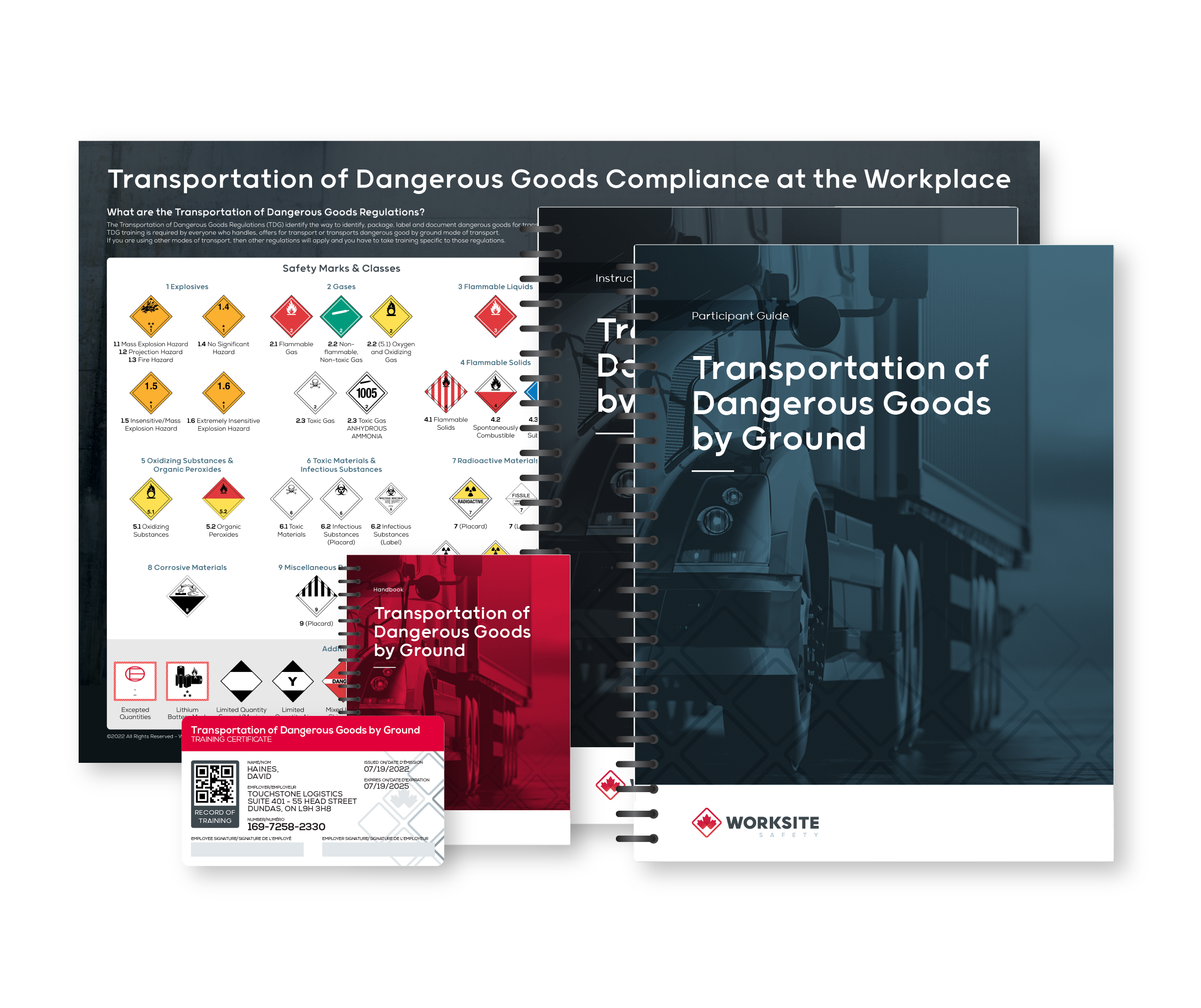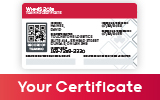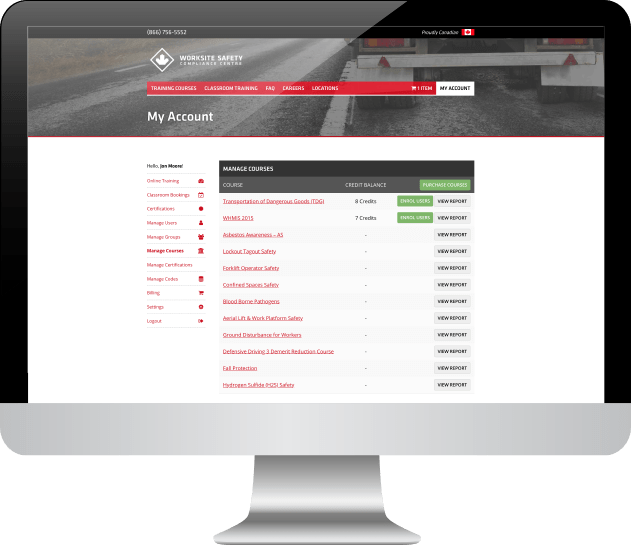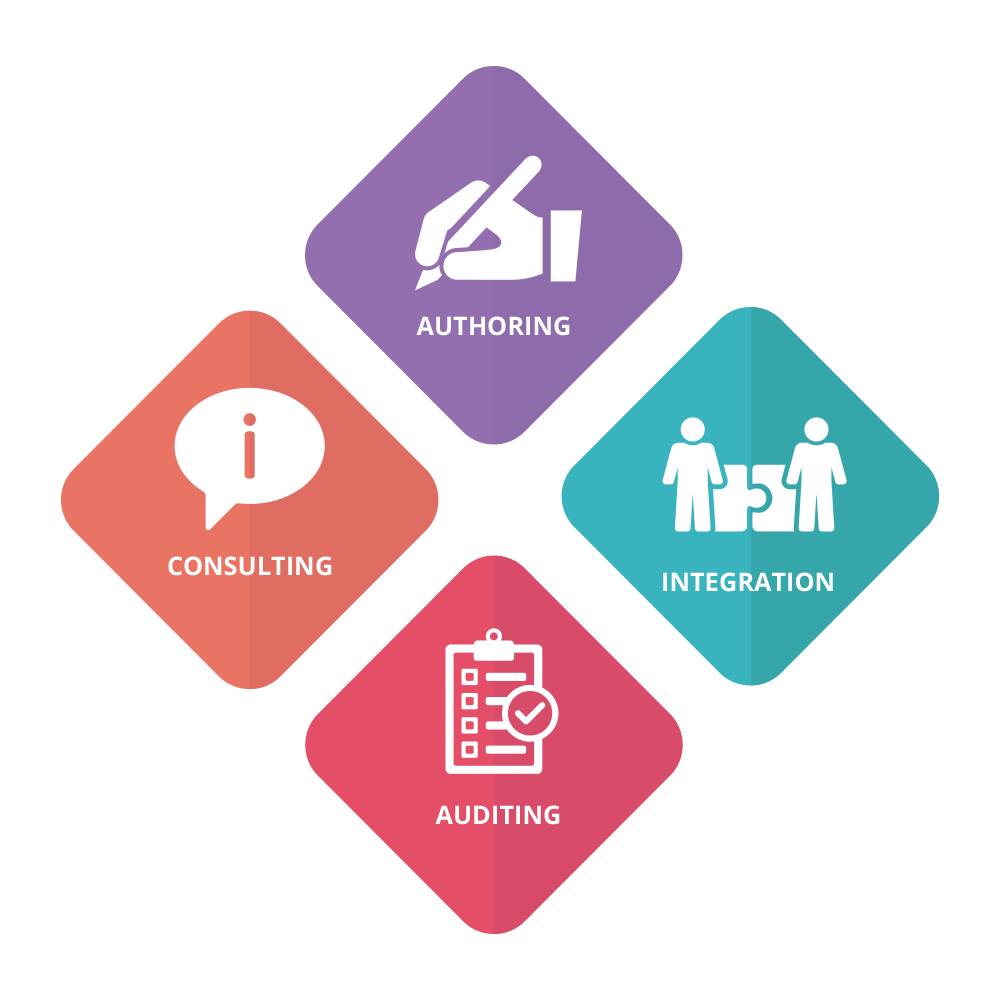TDG by Ground Instructor Training
This instructor training program equips you with all the tools you need in order to train and certify your colleagues, staff or clients in the Transportation of Dangerous Goods by Ground. The course is delivered entirely online. All training materials reflect the current Federal and Provincial legislative compliance requirements.
Once your course is completed, your training resources will be available for download. The student presentation includes off-screen slide-by-slide instructor notes and activities to help keep learners engaged. This presentation format has been designed to work best with TDG Participant Guides.
In addition to your digital assets, you will also receive a physical copy of your Instructor certificates, a TDG Instructor Guide, 10 TDG Participant Guides, and a TDG Handbook. Shipping is included in the purchase price.
The “Participant Guide” enables students to follow along with the latest edition of the classroom presentation. It is a low-cost, light weight, and highly interactive teaching aid. The guide is filled with exercises that have been developed to aid retention and serves as a useful reference tool. Each guide contains an exam as well as a serialized certification card. Certified trainers are required to provide one Participant Guide per participant, per class. Additional guides can be purchased here.
FEATURES INCLUDE:
- FREE Teaching Adults – Introduction to Adult Education Training Program
- TDG Instructor Training Program (online)
- TDG Student Presentation (digital download)
- 1 TDG Instructor Guide
- 10 TDG Participant Guides for Learners with bound-in Exam and Wallet Certificate
- 1 TDG Handbook
- Regular update notifications on new TDG legislation changes
- 1 TDG Poster
- 1 Worksite Branded Presentation Clicker
- 1 Worksite Branded Stress Ball
- 1 Worksite Branded Pen
- 1 Worksite Branded USB
| Average Duration: 8 Hours | |
| Instructor Certificates Issued on Completion | |
| Plastic Proof Of Training Card Available | |
| Applicable Across Canada | |
| Self-Paced. Available 24/7 | |
| Live Support | |
| Permanent Record of Training | |
| Student Management Tools Available |
Course Outline
1. Adult Education: Teaching & Training Adults
Learn about the fundamental principles and strategies that will build your confidence and help you deliver training effectively, every time you step into a classroom.
2. Adult Education: Getting Ready to Train
Learn how to prepare for delivering your course with the aid of a training plan while accounting for the learning environment and any introductory messages that need to be delivered.
3. Adult Education: Icebreakers
Icebreakers covers introductions for adult learners. This includes introductions to the instructor, the purpose of the course, addressing expectations, and brief activities to engage adult learners.
4. Adult Education: Training Adult Learners
Learn about the unique characteristics of training adult learners, strategies for teaching adults, the DISC Model, and behavioral styles.
5. Adult Education: Generating Participation
In most training sessions there are challenges when it comes to making sure all learners are engaged. Learn about useful strategies for asking questions, handling group activities, and requesting feedback.
6. Adult Education: Handling Challenging Learners
Being able to handle challenging learners can ensure a pleasant and productive training experience for all involved. Learn about how to become an effective communicator, overcome barriers, and manage unique challenges.
7. The TDG Act
The introductory chapter of this course outlines major learning objectives, the TDG Act and regulations, TDG background information, requirements, enforcement of the TDG Act, and penalties for violating the act.
8. TDG Training Requirements
Learn about what training is required as a worker as well as what topics must be covered. You will also learn about the specific information required on your training certificates, how to stay up-to-date, special allowances, and how students can show proof of training when required.
9. TDG Classifications
This chapter goes over the different classifications of dangerous goods, how they are classified, how to classify dangerous goods, proofs of classification, divisions within the different classes, packing groups, and approaches used to classify substances.
10. Dangerous Goods Classes
Learn about the 9 classes of dangerous goods as well as their divisions and the hazards they present, including: explosives, gases, flammable liquids, flammable solids, oxidizers, toxic & infectious substances, radioactive materials, corrosives, and miscellaneous products, substances, or organisms.
11. TDG Documentation
The chapter on documentation will teach you about the different types of shipping documents, the role of the consignor, formats, document retention, required information, consist for transport by rail, residue, special cases, quantity changes, procedures during transport, document location, procedures after unloading, hazardous waste, and the movement of documents.
12. Safety Marks
Learn all about TDG safety marks, including labels, placards, orange panels, signs, numbers, letters, and words used to identify dangerous goods and the nature of their danger. You will also learn about the purpose behind various safety marks, your responsibilities, visual requirements, and exemptions.
13. Containers
Chapter 7 provides instruction on various means of containment used when transporting dangerous goods. This includes: small & large means of containment, how to select a means of containment, standardized means of containment, UN certification safety marks, loading and securing containers, and filling containers.
14. Dangerous Goods Incidents
Learn how to respond to incidents regarding dangerous goods. Topics covered include emergency reporting, identifying a release, reportable quantities, release reports, 30-day follow up reports, loss or theft of dangerous goods, and unlawful interference.
15. Emergency Response
The chapter on emergency response covers Emergency Response Assistance Plans (ERAPs), integration with other organizations, when an ERAP is required, ERAP details, the application process, ERAP Reviews, application refusals, revisions, and renewals.
16. Special Situations
Learn about special situations and exemptions to the Transportation of Dangerous Goods Act. Topics covered include gross mass exemptions, class exemptions, limited quantities, and requirements for exemption.
Bulk Discounts. Free Tools.
Some organizations require multiple trainers. Depending on how many instructor training packages you purchase, you may receive a discount. Once purchased, training credits may be used to assign training to users in your account or held for future use.
In addition to the training that you purchase, you will also have access to a number of free training management tools. These tools allow you to add and manage users in your account, distribute training courses, view training progress, print certificates, view records of training, and create customized certification reports to ensure your users are always in compliance.
Additional Services
We put our team of professionals to work to build solutions that improve results, save time, relieve your budget and keep your people safe. In addition to our training programs, we also provide Consulting Services, Train The Trainer Solutions, Course Authoring, and Integration services.
















